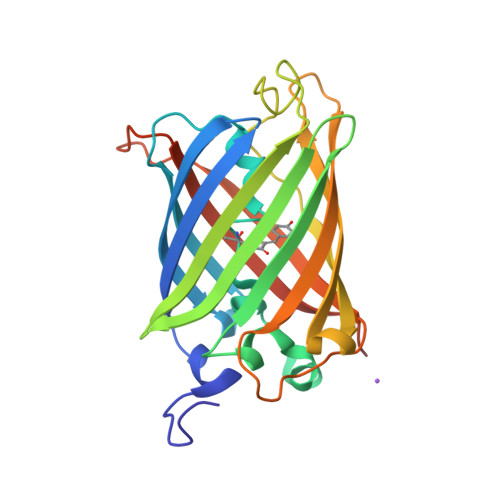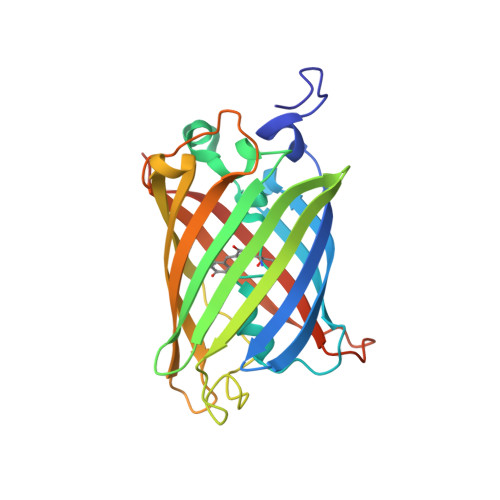Spectroscopic and Structural Study of Proton and Halide Ion Cooperative Binding to GFP
Arosio, D., Garau, G., Ricci, F., Marchetti, L., Bizzarri, R., Nifosi, R., Beltram, F.(2007) Biophys J 93: 232-244
- PubMed: 17434942
- DOI: https://doi.org/10.1529/biophysj.106.102319
- Primary Citation of Related Structures:
2H6V, 2O24, 2O29, 2O2B - PubMed Abstract:
This study reports the influence of halogens on fluorescence properties of the Aequorea victoria Green Fluorescent Protein variant S65T/T203Y (E(2)GFP). Halide binding forms a specific nonfluorescent complex generating a substantial drop of the fluorescence via static quenching. Spectroscopic analysis under different solution conditions reveals high halogen affinity, which is strongly dependent on the pH. This evidences the presence in E(2)GFP of interacting binding sites for halide ions and for protons. Thermodynamic link and cooperative interaction are assessed demonstrating that binding of one halide ion is associated with the binding of one proton in a cooperative fashion with the formation, in the pH range 4.5-10, of a single fully protonated E(2)GFP.halogen complex. To resolve the structural determinants of E(2)GFP sensitivity to halogens, high-resolution crystallographic structures were obtained for the halide-free and I(-), Br(-), and Cl(-) bound E(2)GFP. Remarkably the first high-resolution (1.4 A) crystallographic structure of a chloride-bound GFP is reported. The chloride ion occupies a specific and unique binding pocket in direct contact (3.4 A) with the chromophore imidazolidinone aromatic ring. Unanticipated flexibility, strongly modulated by halide ion interactions, is observed in the region surrounding the chromophore. Furthermore molecular dynamics simulations identified E222 residue (along with the chromophore Y66 residue) being in the protonated state when E(2)GFP.halogen complex is formed. The impact of these results on high-sensitivity biosensor design will be discussed.
Organizational Affiliation:
Scuola Normale Superiore, National Enterprise for nanoScience and nanoTechnology-Consiglio Nazionale delle Ricerche-Instituto Nazionale di Fisica della Materia, Pisa, Italy. d.arosio@sns.it


















